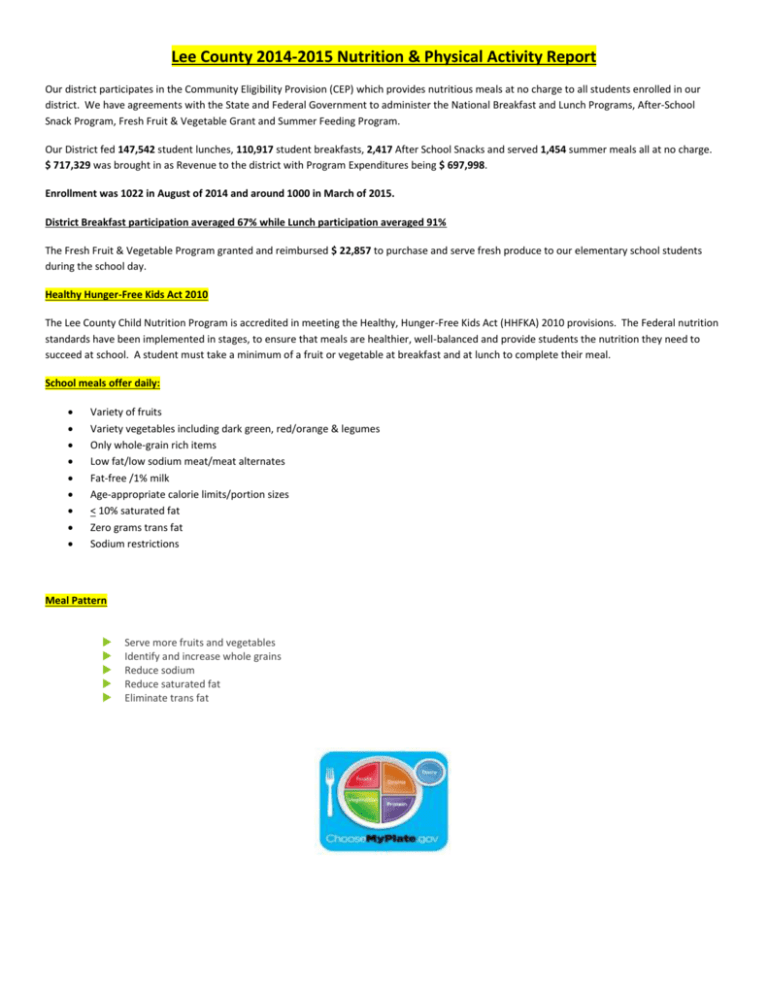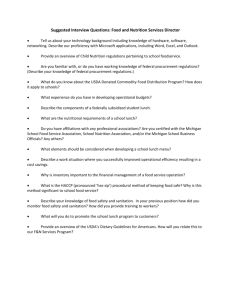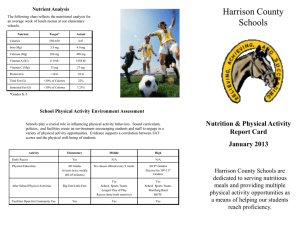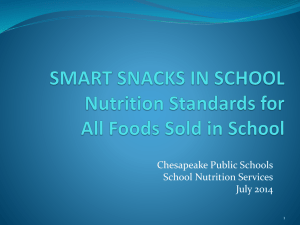Nutrition & Physical Activity Report 2014
advertisement

Lee County 2014-2015 Nutrition & Physical Activity Report Our district participates in the Community Eligibility Provision (CEP) which provides nutritious meals at no charge to all students enrolled in our district. We have agreements with the State and Federal Government to administer the National Breakfast and Lunch Programs, After-School Snack Program, Fresh Fruit & Vegetable Grant and Summer Feeding Program. Our District fed 147,542 student lunches, 110,917 student breakfasts, 2,417 After School Snacks and served 1,454 summer meals all at no charge. $ 717,329 was brought in as Revenue to the district with Program Expenditures being $ 697,998. Enrollment was 1022 in August of 2014 and around 1000 in March of 2015. District Breakfast participation averaged 67% while Lunch participation averaged 91% The Fresh Fruit & Vegetable Program granted and reimbursed $ 22,857 to purchase and serve fresh produce to our elementary school students during the school day. Healthy Hunger-Free Kids Act 2010 The Lee County Child Nutrition Program is accredited in meeting the Healthy, Hunger-Free Kids Act (HHFKA) 2010 provisions. The Federal nutrition standards have been implemented in stages, to ensure that meals are healthier, well-balanced and provide students the nutrition they need to succeed at school. A student must take a minimum of a fruit or vegetable at breakfast and at lunch to complete their meal. School meals offer daily: Variety of fruits Variety vegetables including dark green, red/orange & legumes Only whole-grain rich items Low fat/low sodium meat/meat alternates Fat-free /1% milk Age-appropriate calorie limits/portion sizes < 10% saturated fat Zero grams trans fat Sodium restrictions Meal Pattern Serve more fruits and vegetables Identify and increase whole grains Reduce sodium Reduce saturated fat Eliminate trans fat Students Who Eat a Healthy Breakfast May Do Better In School A study published in Public Health Nutrition shows that there may be a positive link between students’ breakfast quality and consumption and their educational attainment. The study of nearly 5,000 students, aged 9–11, from more than 100 primary schools sought to examine the link between breakfast consumption and quality and subsequent attainment in Key Stage 2 Teacher Assessments 6–18 months later. (Teacher Assessments are the assessment system which replaced SATs in Wales from 2005). Students were asked to list all food and drink consumed over a period of just over 24 hr (including two breakfasts), noting what they consumed at specific times throughout the previous day and for breakfast on the day of reporting. The researchers found that children who ate breakfast, and who ate a better quality breakfast, achieved higher academic outcomes. The odds of achieving an above average educational performance were up to twice as high for pupils who ate breakfast, compared with those who did not. Additionally, eating unhealthy items like sweets and chips for breakfast, which was reported by 1 in 5 children, had no positive impact on educational attainment. “While breakfast consumption has been consistently associated with general health outcomes and acute measures of concentration and cognitive function, evidence regarding links to concrete educational outcomes has until now been unclear,” said lead author Hannah Littlecott, Cardiff University. “This study therefore offers the strongest evidence yet of links between aspects of what pupils eat and how well they do at school, which has significant implications for education and public health policy.” Nutrition Standards Calorie Range Requirements in School Nutrition Breakfast Grades K-5 Grades 6-8 Grades 9-12 350-500 average calories per week 450-600 average calories per week 550-600 average calories per week Grades K-5 Grades 6-8 Grades 9-12 550-650 average calories per week 600-700 average calories per week 750-850 average calories per week Lunch Sodium Range Requirements in School Nutrition Breakfast Grades K-5 Grades 6-8 Grades 9-12 <540mg average sodium per week <600mg average sodium per week <640mg average sodium per week Grades K-5 Grades 6-8 Grades 9-12 <1230 mg average sodium per week <1360mgaverage sodium per week <1420mg average sodium per week Lunch Smart Snacks: Nutrition Standards for Beverages All Schools may sell: Plain water (without carbonation) Unflavored low fat milk Unflavored or flavored fat free milk 100% fruit or vegetable juice and 100% fruit or vegetable juice diluted with water (with or without carbonation) & no added sweeteners. Elementary schools may sell up to 8-ounce portions, while middle schools and high schools may sell up to 12-ounce portions of milk and juice. There is no portion size limit for plain water. Beyond this, the standards allow additional “no calorie” and “lower calorie” beverage options for high school students…with: No more than 20-ounce portions of calorie-free, flavored water (with or without carbonation); and other flavored and/or carbonated beverages that are labeled to contain < 5 calories per 8 fluid ounces or < 10 calories per 20 fluid ounces. No more than 12-ounce portions of beverages with < 40 calories per 8 fluid ounces, or < 60 calories per 12 fluid ounces. Competitive Food Sales apply to ALL foods & beverages sold as fundraisers, vending machines, school stores, school concession stands and any other place that is located on the school campus. Window 1 – is from midnight the night before until 30 minutes after the last lunch period. During this window, no sale of food or beverage may take place except as part of the school breakfast & lunch program. Window 2 – is from 30 minutes after the last lunch period until 30 minutes after the end of the official school day. During this window, food & beverage items sold must meet all nutrition standards in the regulations. Window 3 – is from 30 minutes after the end of the official school day. During this window, there is no nutrient standards restricting what may be sold. This includes weekends & non-school days. To ensure your snack is in incompliance with the Smart Snack Guidelines, use this link to plug in snack information & see how it measured up to the guidelines. http://tools.healthiergeneration.org/calc/calculator/ The District Coordinated School Health Committee would like to take this opportunity to brief you on another critical element of our joint efforts to promote a healthy school environment and to request your support. Like the new school meals, the standards require healthy foods, including more whole grains; low-fat dairy products; fruits and vegetables; and leaner protein with nutrient standards on all foods and beverages sold during the school day. When sending snack items to your child’s school we would like to recommend that you follow the guidance provided below. Beverages: Plain Water, Low-fat Milk, Non-fat flavored or unflavored milk and 100% fruit or vegetable juice or any combination of both totaling 100% with no added sweeteners. Please limit the use of sugar based juices and sodas. Foods: We recommend you bring individually wrapped snacks that are low in fat, calories and sugar. Ex: Whole Grain Crackers, Low-fat Cheese, Pretzels, Low-fat popcorn (no added butter or salt), Graham Crackers, Fat-free or low fat pudding and Gelatins, Cereal Bars, Baked Chips (small portions) Fresh Fruits and Vegetables are always a great choice! Parents may still send their children to school with homemade lunches, or treats for activities such as birthday parties, holidays, and other celebrations. *Check ingredient statements and nutrition information to ensure items meet the USDA Smart Snacks in School nutrition standards. Ensure food allergies of any participants are known before serving any food item. Physical Activity & Achievement Schools play a crucial role in influencing physical activity behaviors. Sound curriculum, policies, and facilities create an environment encouraging students and staff to engage in a variety of physical activity opportunities. Evidence supports a correlation between SAT scores and the physical well-being of students. School Physical Activity Environment 2014 - 2015 Program/Activity Elementary Schools Middle School High School Provide daily recess YES NO NO Minutes of physical education per week 150 min. per week All students receive 150 min. for 9 weeks of SY. 9th graders receive 150 min. for 9 weeks of SY. Provide sequential physical education curriculum consistent with standards YES YES YES Teachers avoid practices that result in student inactivity YES YES YES Offer safe facilities to families/community for physical activity opportunities YES YES YES “Promoting healthy and safe behaviors among students is an important part of the fundamental mission of schools”. School Health Index-Center for Disease Control (CDC) Lee County Coordinated School Health The Lee County Schools’ Coordinated School Health Committee’s first priority is to promote children’s health and well-being. However, feasibility of policy implementation also was considered. The Lee County Schools’ Coordinated School Health Committee has worked diligently to meet local needs and reflect community priorities. When developing the policies, the committee took into account the unique circumstances, challenges, and opportunities within the Lee County School District. A baseline assessment of the schools’ existing nutrition and physical activity environments was completed during the Fall of 2013. Additional assessments were completed during the Fall of 2014. In an effort to assist schools in Kentucky, the Kentucky Department of Education and the Kentucky Department for Public Health have signed an intermediary agreement with the Alliance for a Healthier Generation (AHG) for strengthening the state’s engagement with AHG through KDS’s School Health and Physical (SHAPE) Network. AHG’s Healthy Schools Program framework is a free online tool that helps a school to assess and communicate the program review process and documents to all staff. The document aligns the Healthy Schools Program (HSP) Best Practices to proficient and distinguished characteristics within the PLCS Program Review for the process of evidence identification and program improvement. The PLCS Program Review is intended to be an on-going, year-round, reflective process. Through careful review schools are able to identify strengths and also allow for the identification of weaknesses and areas of growth within the school. Recommendations to improve the Nutrition & Physical Activity Environment include the following: Continue to use the Alliance for a Healthier Generation Assessments and Action Plans to help us improve in all aspects of our District Coordinated School Health, where all schools will develop and utilize a Coordinated Health/Wellness committee to evaluate their schools and implement strategies to increase the overall health and wellness of their students, staff, and families in their school community. Update Wellness Policy to reflect the new food and beverage standards for school meals as well as foods sold on campus and school fundraisers. The District Coordinated School Health Committee is made up of Lee Co. School employees that represent each of the 8 components of Coordinated School Health along with other external committee members. The CSHC is designed to promote and protect the health, wellness and safety of all students and staff, along with assisting them in reaching their full personal, health and academic potential. The committee is working to develop and share resources, model policies and best practices for school and local committees to review and adopt. Include goals for improvement in CSIPs, CDIPs and Strategic Plan. Continue to work with local farmers to incorporate more locally grown items on the menu. Increase teacher awareness of opportunities to provide physical activity in the classroom, gym or on the playgrounds during recess. Promote community physical activities by partnering with community agencies. USDA Nondiscrimination Statement In accordance with Federal civil rights law and U.S. Department of Agriculture (USDA) civil rights regulations and policies, the USDA, its Agencies, offices, and employees, and institutions participating in or administering USDA programs are prohibited from discriminating based on race, color, national origin, sex, disability, age, or reprisal or retaliation for prior civil rights activity in any program or activity conducted or funded by USDA. Persons with disabilities who require alternative means of communication for program information (e.g. Braille, large print, audiotape, American Sign Language, etc.), should contact the Agency (State or local) where they applied for benefits. Individuals who are deaf, hard of hearing or have speech disabilities may contact USDA through the Federal Relay Service at (800) 8778339. Additionally, program information may be made available in languages other than English. To file a program complaint of discrimination, complete the USDA Program Discrimination Complaint Form, (AD-3027) found online at: http://www.ascr.usda.gov/complaint_filing_cust.html, and at any USDA office, or write a letter addressed to USDA and provide in the letter all of the information requested in the form. To request a copy of the complaint form, call (866) 632-9992. Submit your completed form or letter to USDA by: (1) mail: U.S. Department of Agriculture Office of the Assistant Secretary for Civil Rights 1400 Independence Avenue, SW Washington, D.C. 20250-9410; (2) fax: (202) 690-7442; or (3) email: program.intake@usda.gov. This institution is an equal opportunity provider.








